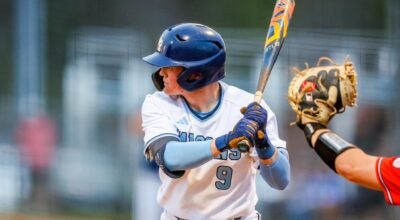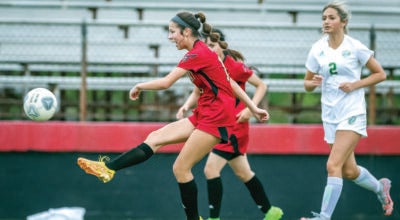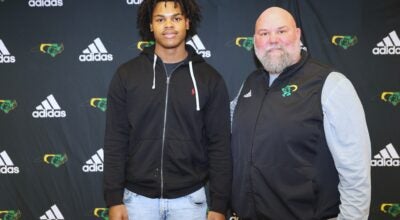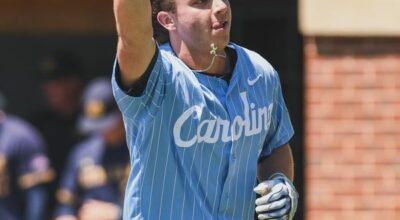Kannapolis 1961 legion team looks back
Published 12:00 am Friday, June 24, 2011
By Mike London
mlondon@salisburypost.com
KANNAPOLIS ó Danny MacArthur Loftin was the best athlete at Troutman High, a sharpshooting roundballer and a gliding, 6-foot-2 shortstop who made tough plays look easy.
Loftin also was the valedictorian of his class, and he managed to hold off pro baseball scouts who pleaded for his signature. He was a serious student headed to Wake Forest and planned to play two sports for the Demon Deacons.
Loftin was smart, but there was one thing he didnít know ó where heíd be playing American Legion ball in the summer of 1961.
Statesville had no team.
Mooresville had no team.
And this was 35 years before South Rowan had one.
Rowan County claimed Loftin. Kannapolis also coveted Loftin, a superb left-handed hitter. He would belong to whomever he lived closer to, and the distance was so tight it would be decided by yards ó not miles.
ěThey measured Legion distances from mail box to mail box,î Loftin said. ěThey drove it. I was just a little closer to Kannapolis.î
The summer of 1961 marked the first time that a team took the field under the banner of Rowan County at Newman Park. There had been years in which Spencer or Granite Quarry fielded teams that competed against the Salisbury squad.
Rowan County had future big-league flamethrower Barry Moore, but not only didnít it get Loftin, it didnít get the southern Rowan boys. The China Grove battery of pitcher Jim Wagoner and catcher Johnny Walker also belonged to Kannapolis Post 115, and those two would be key cogs in a state-championship team.
Kannapolis head coach William James ěBillî Ford was young, just 33 in 1961, but he knew his stuff. Heíd played in the minor leagues from 1947-58 (except two years during the Korean War), and heíd batted a respectable .288 with 84 home runs. Ford had hit a torrid .380 at Ogden, Utah, in 1949 as a 22-year-old, but the two years he lost cost him the chance to move past A ball.
Still, Ford had played with a teenage Frank Robinson at Columbia, S.C., in 1954 and with a youthful Curt Flood at High Point in 1956. He knew talent when he saw it, and he knew his 1961 Kannapolis team was loaded. As a coach at Concord High, heíd coached against many of the Kannapolis athletes. Now he had them on his side.
ěGetting Loftin to play shortstop was a big thing,î Ford said. ěWe had so many good players, and that allowed me to do a lot of things as a coach. Bunt, steal, hit-and-run ó I knew they would execute whatever I asked.î
Fordís assistant was Gerald Blackburn, a minor league teammate. Likely the hardest thrower ever to come out of Kannapolis, the burly southpaw had once fanned 26 batters in a high school game and had fired a 1947 no-hitter for a state-championship Kannapolis team in a regional matchup against Arkansas.
Blackburnís five-year pro career was a bumpy ride ó 12 wins, 39 losses, a million walks ó but he was just 31 in 1961 and still had some lightning in his left arm. He threw batting practice. All the Kannapolis hitters agree the games were easier.
n
Eleven from the 1961 team, still the last Kannapolis team to win a state title, reunited at Fieldcrest Cannon Stadium earlier this week, both to be honored and to talk about how swiftly 50 years have flown by.
Players present were Loftin, Ronnie Woodward, Ronnie Clodfelter, Harry Mills, Grey Clarke, Herky Doster, Bobby Hicks and Mike Lear. Also on hand were Ford, batboy Mickey Hicks (Bobbyís brother) and Ronnie Funderburk, who didnít make the final cut but stayed to throw batting practice. Heís always been considered part of the team.
Walker, the great catcher who hit three homers in a 1961 game against Concord, died young of leukemia after starring for four years for the Georgia Bulldogs.
Outfielder Bobby Compton perished in a plane crash.
Cancer claimed Jim Deaton, the clutch-hitting infielder who gladly moved from shortstop to third base to make room for Loftin.
The surviving members of the gang still get together to tell tall tales and to play the occasional round of golf. Unfortunately, itís often funerals that are the catalysts for their reunions.
When Coach Blackburn died in 2005, team members met with Ford at whatís left of the old ballpark (fire destroyed most of it) and spread his ashes at his favorite place. The final handful they sprinkled where the pitcherís mound had been.
ěThereís still a bond with all of us, and a lot of that is because Coach Ford is such a great guy,î said Doster, the acrobatic second baseman who went to Wake Forest on a football scholarship before graduating from Catawba. n
Kannapolis wouldíve been an all-star team even without Loftin. It was in the midst of a run of four straight Area III titles and veterans were back from a state runner-up effort in 1959 and a Western runner-up finish in 1960.
Mooresvilleís famous 3-D football backfield ó Deaton, Doster and Ronnie Dyson ó was on hand. So was Mooresvilleís Ronnie Clodfelter, one of the fastest outfielders around and a devastating lefty leadoff man.
Clodfelter played left field because A.L. Brownís Harry Mills was in center. Mills was as good an outfielder as anyone had ever seen. He got a supernatural jump on flyballs, a talent that was handy at Kannapolisí Midway Ballpark where the fence in center was 410 feet from home.
Right fielder Ronnie Woodward was also from Brown. He wasnít fleet but he had a terrific arm.
Brownís Grey Clarke, whose father had played third base for the Chicago White Sox in 1944, could fire rising fastballs through brick walls. He and the crafty Wagoner formed a wonderful 1-2 pitching punch.
Fordís second son was born in 1961 and carries the name Brian Clarke Ford. His middle name is a tribute to how great Grey Clarke was.
ěI think if Grey hadnít thrown his arm out, heíd have made the majors,î said Bobby Hicks, who was behind the plate for Clarkeís defining night ó domination of Richmond County in the pivotal game in the state championship series. ěGrey struck out 18 that night. I was catching, and I remember it like yesterday. He went four innings with nothing but strikes. Finally, somebody grounded out.î
n
Even with all that talent, the run in 1961 wasnít a cruise. Kannapolis suffered a harsh blow early when Danny Harkey, the first baseman, broke a leg.
The competition locally was stiff. The second and third-best teams in the state may well have been Area III competition ó Davie County and Asheboro.
Kannapolis won the regular season and swept Lexington three straight in the first round of the playoffs. Game 3 was memorable for Clarkeís marathon relief outing. He worked 10 innings and allowed one hit.
Davie was next, and the pivotal moments came in Game 3 after the teams split the first two. Kannapolis won Game 3 7-6 in the 10th when Mills doubled and scored on Walkerís single.
Walker drove in seven in the 20-3 Kannapolis blowout that ended the series.
In the Area III finals, Kannapolis faced an Asheboro team that had just finished off Rowan County behind star pitcher Snake West. Clarke set the tone in Game 1 with a 13-strikeout shutout.
ěGrey struck out the first four on 12 pitches,î said Woodward, who went on to play at Wingate and UNC. ěThe fifth guy fouled one off. The Asheboro fans gave him an ovation.î
Kannapolis swept its three home games and took the series 4-2 but Game 6 in Asheboro lasted 15 innings, well past midnight. Clodfelter threw out a runner at the plate in the 14th to keep Kannapolis alive.
Kannapolis played for the Western North Carolina championship against Lincolnton-Cherryville, the program that ended its 1960 season. The games in Kannapolisí covered ballpark were Standing Room Only.
ěIt was the townís team,î Mills said. ěJoe Blow that worked in the mill would come out to the game in his overalls. Even football took a backseat to baseball then. Everything took a backseat.î
Mills (struck in the face by a fastball) and Loflin (on a slide) broke their noses in that series, but Clarke dominated games 2 and 4, and Kannapolis rolled four games to one.
Playing without Mills and Walker, Kannapolis lost the first game of the state championship series to Richmond County, but Millsí inspirational return to the lineup and Clarkeís phenomenal 18-strikeout game keyed a 3-2, 10-inning victory in Game 2 that turned it around.
Wagoner pitched seven no-hit innings in Game 3, while Loftin hammered a homer over the scoreboard.
The clincher came at home, a 10-2 romp behind No. 3 pitcher Jim McAbee in front of 4,000 delirious fans.
Kannapolis claimed its title early and had to wait a dozen days for the regional in Sumter, S.C. The players believe they had the best team, but they didnít win it.
The killer was the opener against Colonial Heights, Virginia. With Kannapolis down 7-6, Loftin lined into a double play to end the game.
Clarke and Loftin led Kannapolis past Albany, Ga., in their second game, but then they were eliminated by Miami, Fla., and finished 28-8.
n
ěI would like to have seen what he couldíve done had Harkey not been hurt,î Ford said. ěHe was a veteran and such a competitor. The guys who filled in did a fantastic job, but with him we probably make the World Series. I wanted them to make it. They were special guys. They even loved to practice.î
How good were they?
ěI went on to play at Western Carolina for four years, and Iíve seen a lot of baseball,î Bobby Hicks said. ěThat 1961 team was the best amateur team I ever saw. Fifteen guys, and we all had offers from somebody to play somewhere.î
Hicks lives in Kernersville and takes in Winston-Salem Dash games at the new BB&T Ballpark.
ěThey fill it up pretty good,î he said. ěThe other night, they announced 3,400 fans, and I thought to myself, ëThatís like our Legion team.í î
n
Loftin, who looks youthful despite recent reconstructive shoulder surgery, certainly qualifies for the most interesting post-Legion life.
He did play two sports at Wake, lettering in both, but he abandoned basketball for a shot a pro baseball career.
He signed with the Minnesota Twins in 1965 and had an excellent season for Thomasville in the Western Carolinas League in 1966, batting .296 with 11 homers, 19 doubles and eight triples.
As a member of the New York Mets organization in 1967, he briefly made it up to Double A Williamsport.
After that, he put his Wake education to use. He was appointed to a United Nations post at age 27 and enjoyed a long career in the diplomatic service.
But he probably didnít do anything that was nearly as much fun as 1961.
ěThat whole summer was magical,î Loftin said.





